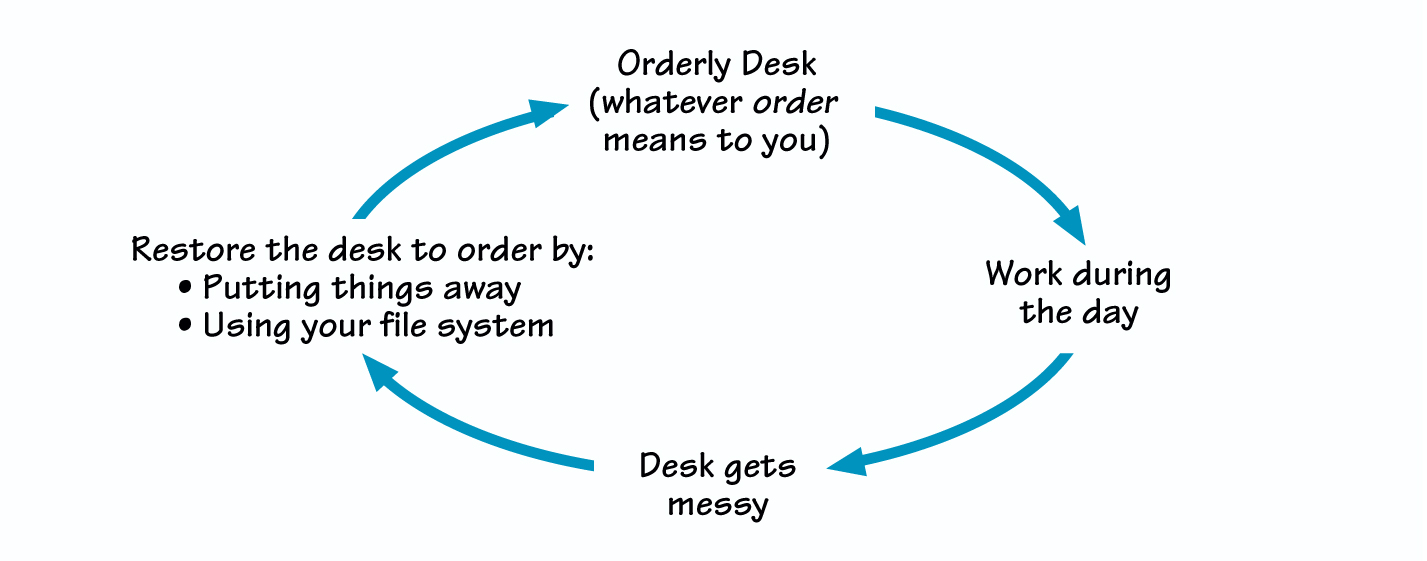Have you ever put an article you intended to read “later” on top of a pile? In her new book It’s Hard to Make a Difference When You Can’t Find Your Keys: The Seven-Step Path to Becoming Truly Organized (Viking Press, 2003), organizational consultant Marilyn Paul offers her personal experience of following this common practice—and of the exploding mountain of paperwork that eventually took over her office. A disorganized person for many years, Marilyn recounts how her chronic messiness adversely affected her work, relationships, home, and health. After failing innumerable times to fix the problem, Marilyn finally realized that to achieve her deepest goals, she needed to change more than her behavior; she had to transform the way she approached her life.
A Seven-Step Process
At first daunted by the challenge, Paul gained a foothold on the problem by beginning to identify how the choices she was making created chaos. She figured out why she was always running late for meetings, constantly losing phone messages, submitting invoices way past deadline—and forever looking for her keys. Understanding that deep personal change requires fundamentally shifting how we think about things, she gradually developed a seven-step process for “changing your mindset so you can do more of what you really want to do” (see “The Seven-Step Change Cycle” on p. 11).
RESTORING ORDER TO YOUR DESK

As you put things away at the end of the day, you feel more energized and ready for what life will offer you the next morning.
In her book, Marilyn provides numerous examples of how to put each step into practice. For instance, in Step One, figuring out your purpose for getting organized, she suggests articulating what you want to do that you currently can’t. If that method doesn’t inspire you, she proposes identifying the costs of disorganization to your life, such as money, time, relationships, family, and spirit. In Step Two, envisioning what you want, the author encourages you to find a metaphor that embodies your idea of being organized, such as a basketball team, a still lake in the wilderness, a beautiful tall ship, or ice dancing. Holding onto this positive image during your journey helps you let go of any negative metaphors that held you back in the past. In Step Three, accurately assessing the source of your mess, Paul outlines four levels of inquiry into your reality—physical, emotional, mental, and spiritual—to reveal the unintended effects of your actions. “Part of organizing,” she explains, “is to internalize a sense of consequence so that you become aware that saving one piece of paper at one point in time could lead you to an overwhelming mountain of papers later on.”
Organizing Wisdom
This kind of systemic approach taps into what she calls “organizing wisdom”—that is, principles for uncovering strategies for taking action. One core principle is getting to ready, or clearing out space in your office and calendar so you can do what you need to do. Another is creating new habits, such as hanging things up and putting things away that continually return you to “ready” (see “Restoring Order to Your Desk”). A third is building effective systems, for example, developing simple routines for tracking phone calls, handling mail, and scheduling meetings.
“As you become more organized, you will find that it is possible to shift from taking action based on anxiety to acting from deep intention,” Marilyn asserts. By engaging in this process, you can replace the stress and discomfort of disorder with a confidence in your extraordinary capabilities to achieve your goals. Piles can become manageable, deadlines can be met, relationships can grow—and you might even appreciate doing your dishes! Ultimately, taking this journey can open up new opportunities to make the difference you have always wanted to make in your life.
THE SEVEN-STEP CHANGE CYCLE
- Establish Your Purpose. Explore why you want to get organized. Notice how disorganization has impeded your growth, and identify how being organized can help you. Make a deep commitment to change.
- Envision What You Want. Create a picture of how you want to live your life. Visualize in detail how being organized can contribute to this vision, and imagine how much better your life will be. Find role models from whom you can learn how to become more organized.
- Take Stock. Look realistically at what you do to create chaos and frenzy in your life. Examine the thinking, beliefs, emotional attachments, and spiritual orientation that lead you to disorganization.
- Choose Support. Accept the fact that you need help getting organized, and identify people who can support you in this change process.
- Identify Strategies for Change. Learn the principles of becoming organized. Clear up the backlog, build new systems, develop new habits, manage time effectively, handle purchases well, focus your attention on priorities, and make sure you keep your word.
- Take Action. Ground yourself in your vision and purpose, and commit to getting the results. Set reasonable goals for organizing yourself, allocate time to work on them, energize yourself when you get stuck, and arrange for someone to help you.
- Go Deeper to Keep Going. Learn how to face the deep inner challenges and obstacles that may arise during the organizing process. Understand how the change cycle works, prepare yourself for setbacks, and work on overcoming destructive habits. Deepen your understanding of how you want to live and what it takes to live that way.
Kali Saposnick is publications editor at Pegasus Communications.
